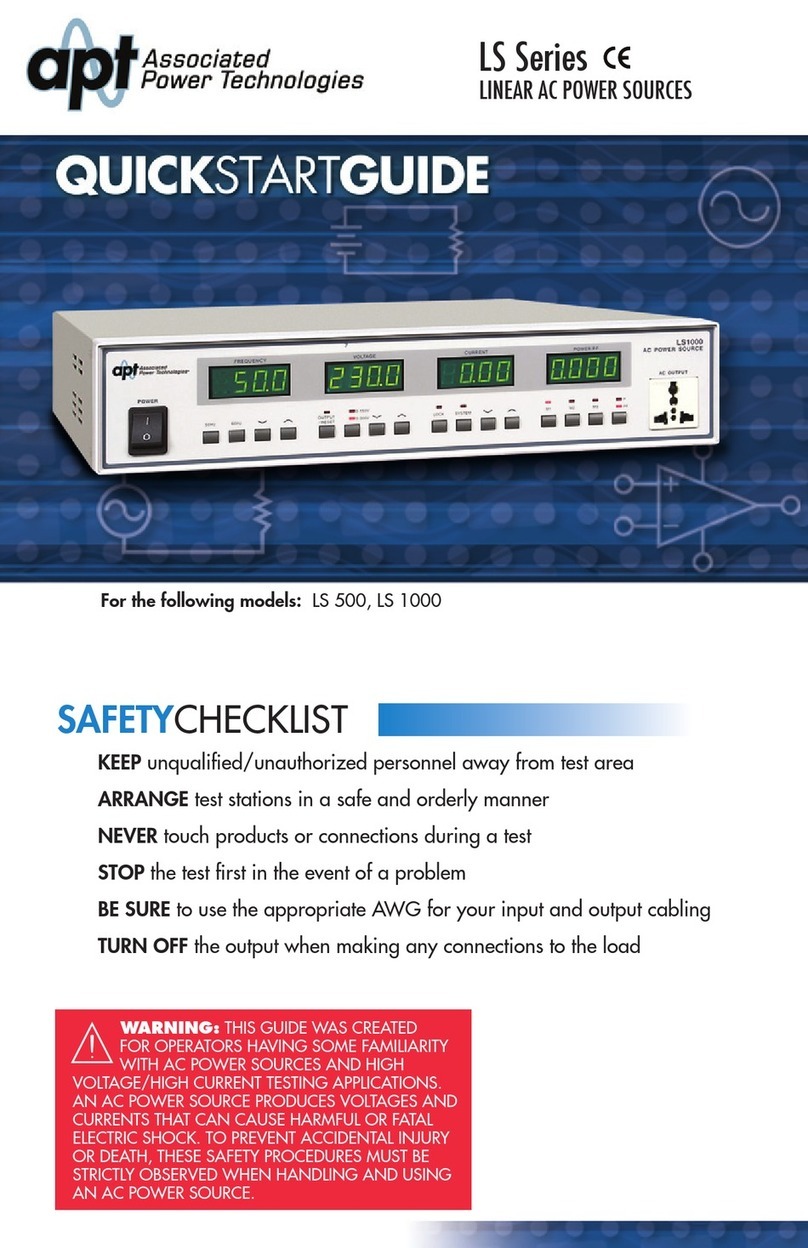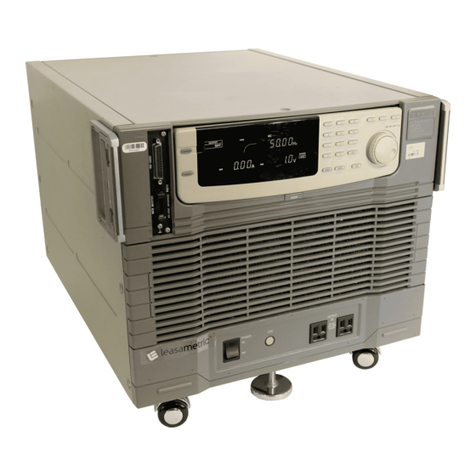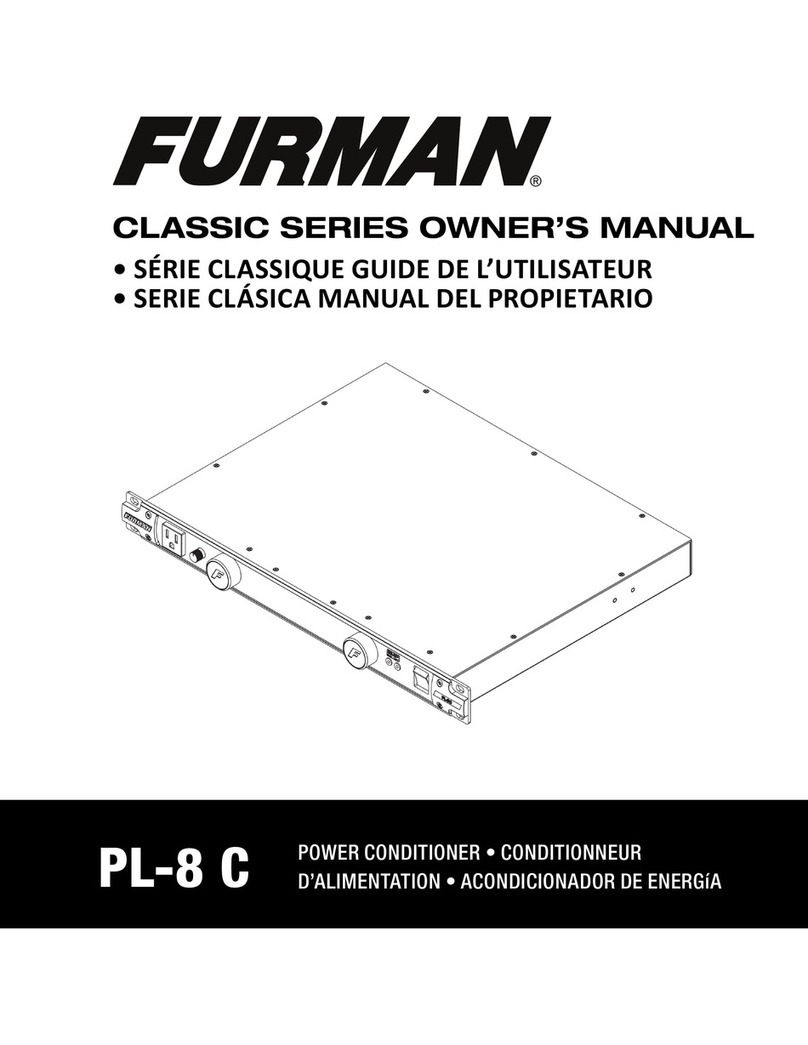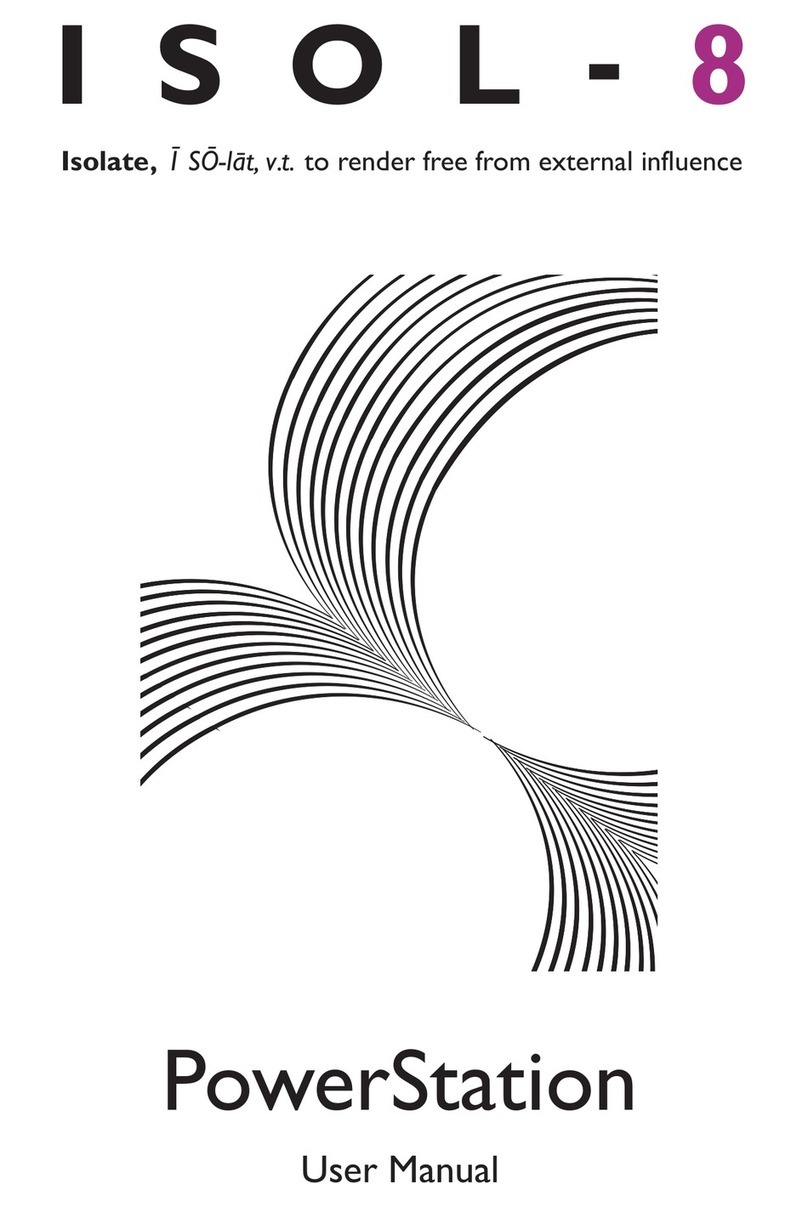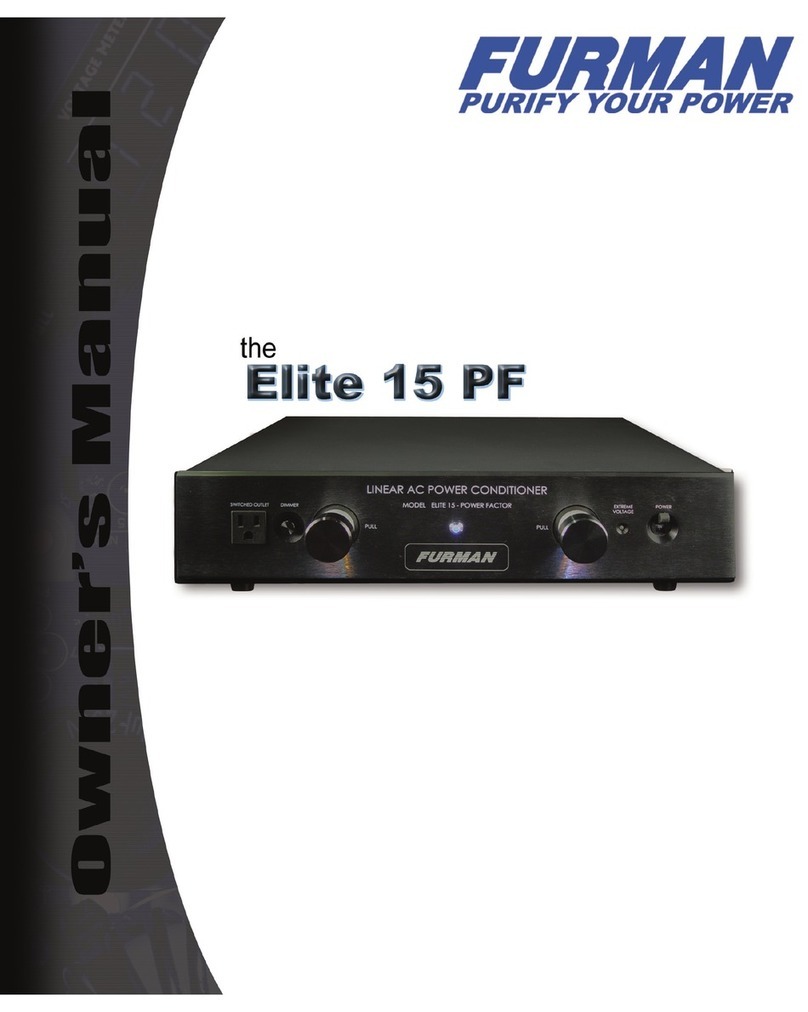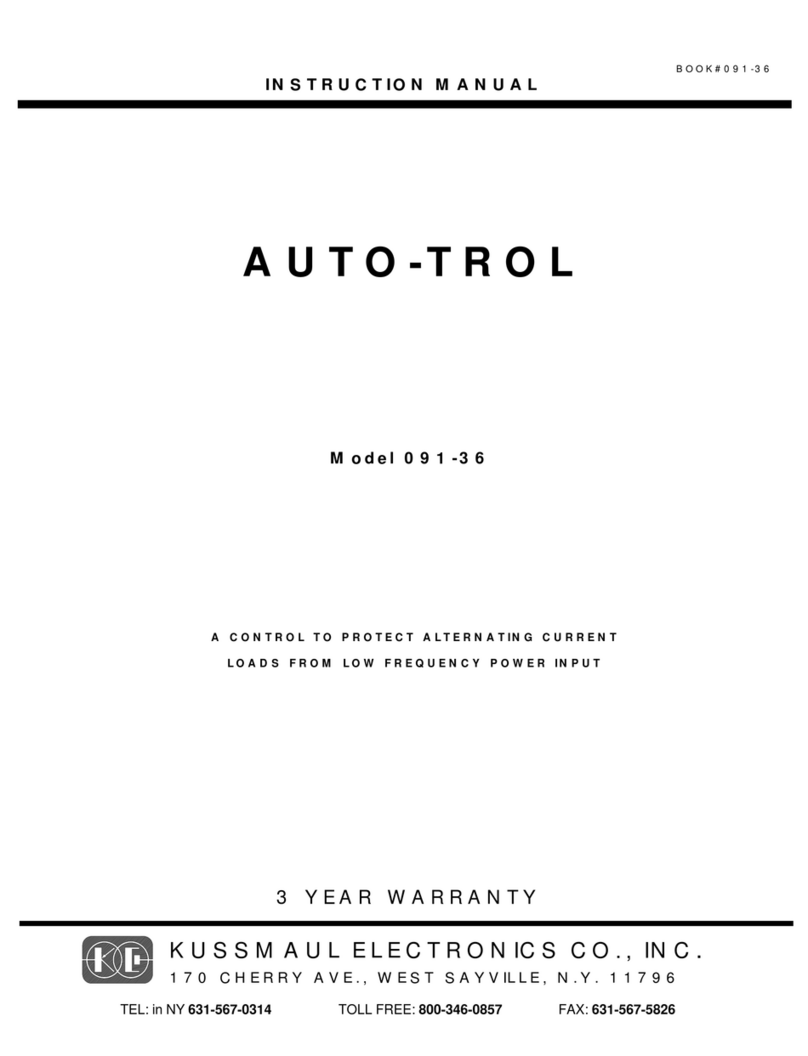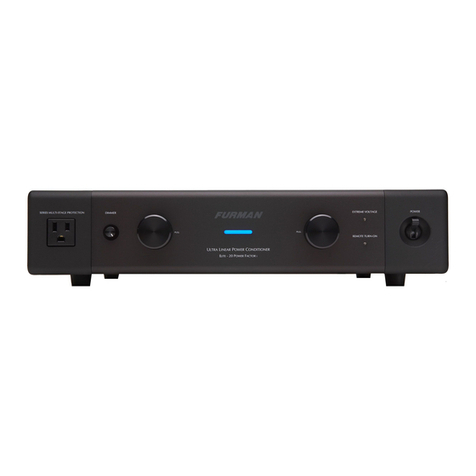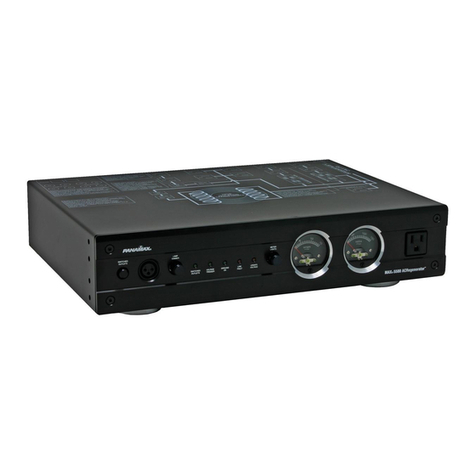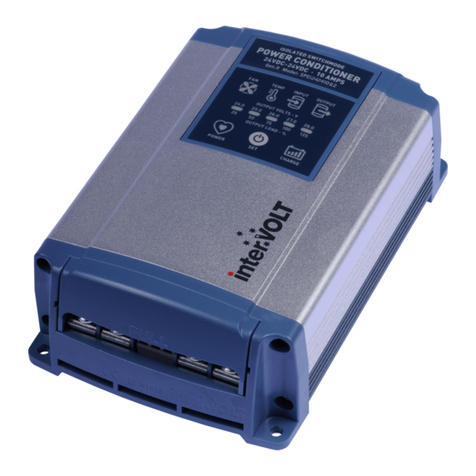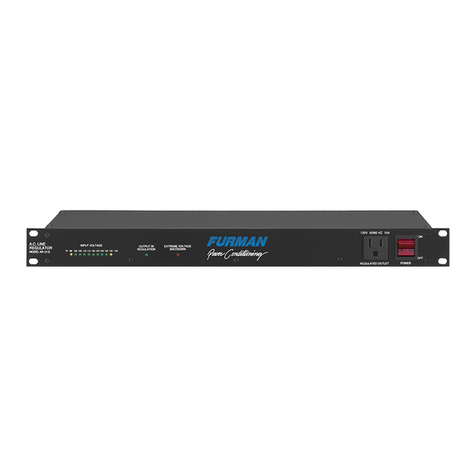Clore Automotive Booster pac ES2500 User manual

E
S
P
A
Ñ
O
L
This unit has a sealed lead acid battery that should be kept at full charge. Recharge
when first received, immediately after each use, and every six months if not used (this
charger contains a smart circuit which allows it to be left on charge continuously
without damage). Failure to do this may cause the battery life to be reduced greatly.
Dear Customer: CONGRATULATIONS. You have just purchased the finest quality
portable power source and engine starters on the market. We have taken numerous
measures in quality control and in our manufacturing processes to ensure that your
product arrives in top condition, and that it will perform to your satisfaction. In the rare
event that your portable power source contains a damaged or missing item, does not
perform as specified, or requires warranty service, DO NOT RETURN YOUR
PORTABLE POWER SOURCE TO THE STORE.
Please call our TOLL FREE NUMBER US (800-328-2921) CN (800-668-8642) and
ask for Technical Service. Our technical service representative will expedite delivery of
your part. If your product needs warranty service, our technical service representative
will help you obtain the fastest remedy possible under the warranty. Save your
purchase receipt, it is required for warranty service.
PORTABLE POWER SOURCE
USER’S MANUAL
Consumer: Retain these instructions for future use. Read all instructions
carefully before using this portable power source.
© CMC February 1999 Form No. 842-270-000
F
R
A
N
Ç
A
I
S
N
E
D
E
R
L
A
N
D
S
P
O
R
T
U
G
U
Ê
S
E
N
G
L
I
S
H
1
Figure 1. Portable Power Source
SAFETY SUMMARY
SAVE THESE INSTRUCTIONS – This
manual contains important safety and
operating instructions.
Contains sealed, non-
spillable lead acid
battery. Must be
disposed of properly.
WARNING
RISK OF EXPLOSIVE
GASES.
• Working in the vicinity of a lead
acid battery is dangerous.
Batteries generate explosive
gases during normal battery
operation. For this reason, it is
essential that you read this
manual and follow the
instructions exactly.
• To reduce risk of battery
explosion, follow these
instructions and those published
by battery manufacturer and
manufacturer of any equipment
you intend to use in vicinity of
T
E
S
T
C
H
A
R
G
E
D
POWER LEVEL
EF
1
2
3
4
5
6
78
910
1. Safety storage holsters
2. CHARGED indicator light
3. Multiple LED power indicator
4. Case
5. TEST switch
6. Accessory outlet
7. Heavy-duty Clamps
8. Flexible heavy-duty cables
9. Wall charger
10. Power charging cord (optional)
Not shown, charging socket (on rear or side)
Pb
842-270-000 Portable Power Source En, Sp, Fr, Pg, Du.p65 3/12/01, 10:14 AM1

E
N
G
L
I
S
H
2
battery. Review cautionary
marking on these products and on
engine.
PERSONAL PRECAUTIONS
• Someone should be within range
of your voice or close enough to
come to your aid when you work
near a lead-acid battery.
• Have plenty of fresh water and
soap nearby in case battery acid
contacts skin, clothing, or eyes.
• Wear complete eye protection and
clothing protection. Avoid touching
eyes while working near battery.
• If battery acid contacts skin or
clothing, wash immediately with
soap and water. If acid enters
eye, immediately flood eye with
running cold water for at least 10
minutes and get medical attention
immediately.
•NEVER smoke or allow a spark or
flame in vicinity of battery or
engine.
• Be extra cautious to reduce risk of
dropping a metal tool onto battery.
It might spark or short circuit
battery or other electrical part that
may cause explosion.
• Remove personal metal items
such as rings, bracelets, necklaces
and watches when working with a
lead-acid battery. A lead-acid
battery can produce a short-circuit
current high enough to weld a ring
or the like to metal causing a
severe burn.
• Use portable power source for
charging or boosting LEAD-ACID
battery only. Do not use for
charging dry-cell batteries that are
commonly used with home
appliances. These batteries may
burst and cause injury to persons
and damage to property.
•NEVER charge or boost a frozen
battery.
•NEVER allow clamps to touch
together or to contact the same
piece of metal to prevent arcing.
IMPORTANT SAFETY
INSTRUCTIONS
• Use of an attachment not
recommended or sold by the
manufacturer, may result in a risk
of damage to the unit, or injury to
personnel.
• When using the wall charger or
power extension cord, pull on the
plug and NEVER ON THE WIRE
when disconnecting.
• Do not recharge the portable
power source with a damaged wall
charger or power extension cord.
Replace them immediately.
• The portable power source may be
used under any weather condition.
Rain, snow, hot, or cold
temperatures.
• Do not submerge in water.
• Do not operate with flammables
such as gasoline etc.
• If the portable power source
receives a sharp blow or is
otherwise damaged, in any way,
have it checked by a qualified
service person. If the portable
power source is leaking battery
acid do not ship it. Take it to the
closest battery recycler in your
area.
• Do not disassemble the portable
power source. Have it checked by
a qualified service person.
•The portable power source should
never be left in a total discharged
state for any period of time.
Damage to the battery could be
permanent with poor performance
as a result. When not in use,
leave the portable power source
connected to the wall charger or
recharge every six (6) months.
842-270-000 Portable Power Source En, Sp, Fr, Pg, Du.p65 3/12/01, 10:14 AM2

E
N
G
L
I
S
H
3
C
H
A
R
G
E
D
POWER LEVEL
F
E
T
E
S
T
C
H
A
R
G
I
N
G
Figure 2. Test Button, Charging and
Charged LED’s
EF
POWER LEVEL
T
E
S
T
C
H
A
R
G
I
N
G
C
H
A
R
G
E
D
1. With J2000 turned off hook the red
clamp to the weak battery's positive
(+) terminal, hook he black clamp to
a metal part of the vehicle's frame.
2. Push button (below) to turn J200-on.
3. Turn the vehicle ignition.Once vehicle
starts. turn the J2000 off by
pushing button again.
4. Disconnect J2000 clamps from
battery
OFF ON
Figure 3. Indicator Panel (J2000)
RECHARGE THE
PORTABLE POWER
SOURCE
Note: There are two ways to charge
the portable power source.
The first method is automatic
charging with the provided
wall charger (preferred). The
second is through the dc
power jack through the power
extension cord. The second
method is not automatic and
requires watching because the
portable power source could
be damaged due to
overcharging.
1. With the wall charger. The portable
power source is automatically
charged using the wall charger. A
CHARGING JACK (may be found in
the rear or on a side of your
portable power source) is
connected through a smart circuit
board to the portable power source
making recharging automatic.
Recharging takes approximately 4
to 6 hours for each light that does
not come on when the test button is
pressed. Overcharging is not a
problem when using the wall
charger and the portable power
source can be left connected to the
wall charger indefinitely.
PORTABLE POWER
SOURCE FEATURES
• Provides plenty of power for
starting vehicles. More than
enough to start most cars. May
also be used in DEEP CYCLE
applications.
• The portable power source will
power most 12 Vdc accessories
equipped with a male cigar lighter
plug. The dc outlet has automatic
overload protection.
• Test switch and LED lights. State
of the art circuit.
INFORMATION TO USER
Changes or modifications to the portable
power source, by the user, that are not
expressly approved by the party
responsible for radio frequency emission
levels from the portable power source,
could cause an undesireable amount of
radio frequency energy to be emitted.
Such action could void the user’s
authority to use the portable power
source.
SAFETY FEATURES
• Safety storage holsters prevent
accidental sparking of clamps and
rotate 90° for easy clamp removal.
• Cable grooves lock the cables for
clean storage. (No unsightly
dangling wires).
• The portable power source
contains the latest technology with
its 12 volt sealed non spillable
battery. The portable power source
may be stored in any position.
RECHARGING
PROCEDURES
When new, your portable power source
should be charged for a minimum of 30
hours, unless all the power level lights
and the charged light come on when the
test button is pressed.
842-270-000 Portable Power Source En, Sp, Fr, Pg, Du.p65 3/12/01, 10:14 AM3

E
N
G
L
I
S
H
4
a. Insert the wall charger plug
(see Figure 1) into the
CHARGING JACK (mounted
in the rear or on one side of
the portable power source)
b. Connect the wall charger AC/
DC ADAPTOR to the ac
outlet (the yellow CHARGING
light will light).
c. Allow the portable power
source to charge until the
CHARGED light comes on
(you can monitor the
progress by checking the red
POWER LEVEL lights – when
all three POWER LEVEL
lights are lit the CHARGED
light should come on).
d. Once the CHARGED light
comes on, charge another
three to six hours, (three
hours is acceptable but to
ensure maximum output
capability, six hours is
preferred).
e. If you are not going to need
the portable power source
right away you may leave the
wall charger connected to the
portable power source. We
recommend that the wall
charger remain connected to
the portable power source
whenever the portable power
source is not in use.
2. With the Optional Extension Cord.
Start the vehicle engine. Plug one
end of the power extension cord
into the portable power source
power receptacle and the other end
into a vehicle lighter outlet. Press
the test button once every hour to
check the POWER LEVEL. When
all of the red lights and the charged
light come on, charge the portable
power source another 1 to 2 hours
to insure a complete recharge. DO
NOT OVERCHARGE! This is not
an automatic method of charging
the portable power source. You
must frequently monitor the
charging process (POWER LEVEL
indicators by pressing the TEST
button) to ensure the portable
power source is not overcharged.
Overcharging will damage your
portable power source.
Note: Test button needs to be
pressed to check power level
and charged light.
OPERATING
INSTRUCTIONS
USED AS A BATTERY
CHARGER
The portable power source is intended,
primarily, to be used to start or restart a
vehicle when the battery in the vehicle
has become run down to the point that it
will not start the vehicle without
assistance. However, the portable power
source can also be used to restore some
charge to the vehicle battery.
1. Plug the power extension cord from
the portable power source to the
vehicle cigar lighter outlet for 30
minutes.
Note: Some vehicle ignition keys
must be turned to accessory
to activate the cigar lighter
socket.
2. Remove the power extension cord
and start the car.
Note: A defective battery may refuse
to accept a charge from the
portable power source.
USED AS AN EMERGENCY
JUMP STARTER
Note: For optimum performance, do
not store below 50° when
using as a jump starter.
842-270-000 Portable Power Source En, Sp, Fr, Pg, Du.p65 3/12/01, 10:14 AM4

E
N
G
L
I
S
H
5
For The Typical Portable Power
Source
1. Turn ignition off before making
cable connections.
2. Use in a well ventilated area.
3. SHIELD EYES.
4. Clamp the positive (red +) clamp to
the positive terminal on the weak
battery (for negative ground
system).
5. Clamp the negative (black –) clamp
to the vehicle frame (ground).
Make sure the cables are not in the
path of moving belts or fan.
6. Stay clear of batteries while jump
starting.
7. Start the vehicle (turn on the vehicle
ignition).
Note: If the vehicle doesn’t start
within 6 seconds, let the
portable power source’s
internal battery cool for 3
minutes before attempting to
start the vehicle again or
damage to the portable power
source may occur.
8. When the vehicle is started,
disconnect the negative (–) battery
clamp from the vehicle frame.
9. Disconnect the positive (+) clamp.
10. Store the clamps in the holsters.
For The J2000 Portable Power
Source Only
1. Turn ignition off before making
cable connections.
2. Use in a well ventilated area.
3. SHIELD EYES.
4. Verify that the portable power
source is turned OFF (ON/OFF
switch is out, see Figure 3 and
Figure 4).
OFF ON
Figure 4. ON/OFF Switch (J2000)
5. Clamp the positive (red +) clamp to
the positive terminal on the weak
battery (for negative ground
system).
6. Clamp the negative (black –) clamp
to the vehicle frame (ground). Make
sure the cables are not in the path
of moving belts or fan.
7. Press the ON/OFF button to turn
the portable power source ON.
8. Start the vehicle (turn on the vehicle
igntion).
9. Stay clear of batteries while jump
starting.
Note: If the vehicle doesn’t start
within 6 seconds, let the
portable power source internal
battery cool for 3 minutes
before attempting to start the
vehicle again or damage to
the portable power source
may occur.
10. When the vehicle is started, press
the portable power source ON/OFF
switch to turn the portable power
source OFF and disconnect the
negative (–) battery clamp from the
vehicle frame.
11. Disconnect the positive clamp +.
12. Store the clamps in the holsters.
USED AS AN ALTERNATIVE
POWER SUPPLY FOR
VEHICLES
The portable power source is an
ESSENTIAL tool for all who replace
automobile batteries. Most vehicles have
some type of electronic component with
memory, such as alarm systems,
computers, radios, phones, etc. and when
the vehicle battery is replaced, the
memory is lost. However, if the power
extension cord is plugged from the
portable power source to the cigar lighter
on the vehicle, the memories can be
saved.
842-270-000 Portable Power Source En, Sp, Fr, Pg, Du.p65 3/12/01, 10:14 AM5

E
N
G
L
I
S
H
6
USED AS A MULTIPURPOSE
POWER SUPPLY
The portable power source is also a
portable power source for all 12 Vdc
accessories equipped with a male cigar
lighter plug. The dc outlet has automatic
overload protection.
When the portable power source is used
with an inverter, it can operate
appliances normally powered by 120
Vac, or 220 Vac.
Recommended inverter for the portable
power source is 300 watts maximum. For
more information contact your nearest
portable power source Dealer.
TROUBLESHOOTING
Problem: 1 or 2 red lights come on,
charger is plugged in for 24
hours and there is no
change in status of lights.
Answer: Check charger to see if it is
charging. Charger should be
warm.
Problem: Charger works well but still
no change in status of lights
when the wall charger is
connected to the portable
power source (yellow light is
on).
Answer: Possible defective battery or
faulty breaker. Try using a
device (light, TV, etc.) with a
lighter plug on it to see if it
works. Should it work,
portable power source
breaker is OK and the
battery is the problem.
Problem: All of the lights come on
when the charger is plugged
into the portable power
source, but when the
charger is unplugged and
the test button pressed, no
lights come on.
Answer: Portable power source has
a defective battery.
Question: What will cause this?
Answer: Intense use without
allowing a cool down
period: SEE NOTE: USED
AS AN EMERGENCY
JUMP STARTER.
Problem: Portable power source is
fully charged but has no
power.
Answer: Check where the wire
meets the jaw on the
portable power source
clamp. Make sure they are
well crimped, or if your unit
has a power switch, make
sure it is in the on position.
Problem: When trying to use an
accessory through the cigar
lighter outlet on the portable
power source, I heard a
clicking sound coming from
inside the portable power
source.
Answer: The accessory is drawing
too many amps, causing the
internal circuit breaker to
cycle ON and OFF. There
may be a problem with the
accessory (such as a short
circuit) that is causing the
overload condition.
QUESTIONS &
ANSWERS
Question: How many jump starts can
a fully charged BOOSTER
PAC do before needing to
be recharged?
Answer: 1 to 30. Factors are
temperature, general
condition of vehicle, engine
type and size.
Question: Can the portable power
source's battery be
replaced?
Answer: Yes, call Technical Service
at U.S.(800)328-2921 or CN
(800)668-8642.
842-270-000 Portable Power Source En, Sp, Fr, Pg, Du.p65 3/12/01, 10:14 AM6

E
N
G
L
I
S
H
7
Question: Can the portable power
source be recycled?
Answer: Yes, the environment was
one of our main concerns in
the development and design
of the portable power
source. Most battery outlets
can dispose of this product
at its life's end. In fact, your
portable power source
contains a sealed non-
spillable lead acid battery
and must be properly
disposed of BY LAW. See
BATTERY REMOVAL
INSTRUCTIONS.
Question: What is the ideal in-use
storage temperature of the
portable power source?
Answer: Room temperature. The
portable power source will
also operate at below zero
temperatures, however its
power will be less. Intense
heat will accelerate self
discharge.
Question: I have a regular 10 amp
battery charger, can I use it
to recharge the portable
power source?
Answer: No, only the supplied wall
charger should be used.
Question: Is the portable power
source goof proof?
Answer: No. Jump starting
instructions must be
followed. See back of
portable power source.
Question: I'm recharging my portable
power source, should the
yellow charged light
immediately come on?
Answer: No. First the yellow
CHARGING light will come
on to indicate the charging
process is beginning, then
the red POWER LEVEL
lights come on in sequence
as the level of charge
increases. Finally, the green
CHARGED light will come
on, but only when the
portable power source
approaches full charge.
Question: How long should I charge
the portable power source?
Answer: Your portable power source
can be left on the wall
charger continuously. Your
portable power source
should be charged for a
minimum of 30 hours when
new. To recharge with the
wall charger the portable
power source should be
charged for 4 to 6 hours per
light that doesn’ t come on
when the TEST button is
pressed.
Question: How do I know when the
portable power source is
fully charged?
Answer: Follow all charging
instructions, remove the
portable power source from
the wall charger and press
the TEST button. If all
power indicator lights and
the CHARGED (or
CHARGING) light come on,
the portable power source is
fully charged.
Question: How can I test the battery in
my portable power source
to see if it needs to be
replaced?
Answer: The manufacturer
recommends that you use a
100 amp battery load tester.
Load the portable power
source battery for 6
seconds with a 100 amp
load and it should maintain
at least 9 Vdc.
842-270-000 Portable Power Source En, Sp, Fr, Pg, Du.p65 3/12/01, 10:14 AM7

E
N
G
L
I
S
H
8
TESTING THE
BATTERY
After fully charging the battery so all red
lights come on, apply a 100 amp load to
the vehicle charging plug (on the
portable power source), for a period of 6
seconds, while monitoring the battery
voltage (at the vehicle charging plug).
The battery is good if the voltage is 9
Vdc or higher.
BATTERY REMOVAL
AND DISPOSAL
INSTRUCTIONS
Contains sealed, non-
spillable lead acid battery.
Must be disposed of
properly.
!!! IMPORTANT !!!
REMOVAL AND DISPOSAL
The battery inside this portable power
source is a sealed lead-acid battery.
By LAW, it is required to be removed
and recycled or disposed of properly.
While there are federal regulations that
must be complied with throughout the
United States, your individual state or
local governments may have additional
regulations to be followed.
When the battery in this product is in
need of replacement, remove it
according to the instructions provided
below and take it to your local recycling
center for proper recycling or disposal.
If you don’t have a local recycling center
that handles sealed lead-acid batteries,
contact your local environmental agency
for instructions.
REMOVAL INSTRUCTIONS
Begin by making sure that both booster
clamps are securely stowed in their
holsters on each side of the portable
power source.
1. Lay the portable power source
down on its front. On the back of
the unit, locate the four screws that
hold the portable power source
enclosure together (TWO ALONG
THE LEFT EDGE AND TWO
ALONG THE RIGHT EDGE).
2. Remove the four screws, then lift off
the back half of the portable power
source enclosure.
3. On the top of the battery are two
terminals, each with wires
connected to them. Disconnect
these wires from the battery by
removing the bolts that hold them to
the battery terminals. TO
PREVENT ACCIDENTAL ARCING,
be careful not to touch both battery
terminals with the tools being used
to remove the bolts.
4. Lift the battery out of the front half
of the enclosure.
5. To install a new battery, reverse the
above procedure.
Note: Remember that the red wires
connect to the positive (+)
battery terminal and the black
wires connect to the negative
(–) battery terminal.
Pb
842-270-000 Portable Power Source En, Sp, Fr, Pg, Du.p65 3/12/01, 10:14 AM8

E
S
P
A
Ñ
O
L
9
UNIDAD PORTÁTIL DE
ALIMENTACIÓN ELÉCTRICA
Esta unidad tiene una batería de plomo-ácido sellada que deberá mantenerse a
plena carga. Recargue la batería por primera vez cuando la reciba, luego deberá
cargarla después de cada uso o cada seis meses si no la usa (este cargador tiene un
circuito inteligente que permite dejarlo en carga continuamente sin riesgo de daño).
Si no toma esta precaución, la duración de la batería podría reducirse
considerablemente.
Estimado cliente: FELICITACIONES. Acaba de comprar la unidad de alimentación
eléctrica y arrancador de motor portátil de mejor calidad en el mercado. Hemos
tomado numerosas medidas en control de calidad y en nuestros procesos de
fabricación para asegurarnos de que su producto le llegue en óptimas condiciones y
funcione en forma satisfactoria. En el caso poco probable de que su unidad portátil de
alimentación eléctrica contenga una pieza dañada o que le falte una pieza, o de que
no usted no obtenga el resultado esperado según las especificaciones, o de que
requiera servicio bajo la garantía, NO DEVUELVA SU UNIDAD PORTÁTIL DE
ALIMENTACIÓN ELÉCTRICA A LA TIENDA.
Llame a nuestro NÚMERO DE TELÉFONO GRATUITO en E.U.A. (800-328-2921), o
en Canadá (800-668-8642) y pida la extensión de Servicio Técnico (Technical
Service). Nuestro representante de servicio técnico agilizará la entrega de su repuesto.
Si el producto requiere servicio bajo garantía, nuestro representante de servicio
técnico le ayudará con la solución más rápida posible para su garantía. Guarde su
recibo de compra, porque se lo pedirán para el servicio de garantía.
© CMC Febrero 1999
Nota al usuario: Guarde estas instrucciones para uso futuro. Lea todas las
iinstrucciones detalladamente antes de usar esta unidad de alimentación eléctrica portátil.
Figura 1. Unidad portátil de alimentación
RESUMEN DE
SEGURIDAD
CONSERVE ESTAS INSTRUCCIONES –
Este manual contiene instrucciones de
seguridad y de funcionamiento
importantes.
Contiene una batería sellada
de plomo-ácido, a prueba de
derrames. Debe desecharse
en la forma apropiada.
ADVERTENCIA
RIESGO DE GASES
EXPLOSIVOS.
• Trabajar cerca de acumuladores
es peligroso. Las baterías
generan gases explosivos durante
el funcionamiento normal. Por
eso, es sumamente importante
que lea este manual antes de usar
1. Cubiertas de seguridad para las pinzas
2. Luz indicadora de carga completa (CHARGED)
3. Indicador múltiple de potencia LED
4. Estuche
5. Interruptor de prueba (TEST)
6. Tomacorriente para accesorios
7. Mordazas de trabajo pesado
8. Cables flexibles de uso pesado
9. Cargador de pared
10. Cable de extensión (opcional)
Enchufe de carga atrás o al costado
(no se muestra)
T
E
S
T
C
H
A
R
G
E
D
POWER LEVEL
EF
1
2
3
4
5
6
78
910
9Publicación No. 842-270-000
Pb
842-270-000 Portable Power Source En, Sp, Fr, Pg, Du.p65 3/12/01, 10:14 AM9

E
S
P
A
Ñ
O
L
10
la unidad de alimentación
eléctrica portátil y que siga
exactamente las instrucciones.
•Para reducir el riesgo de
explosiones de la batería, siga
estas instrucciones asícomo las
instrucciones publicadas por el
fabricante de la batería y el de
cualquier otro equipo que se use
cerca de la misma. Preste
atención a las indicaciones de
precaución en estos productos y
en el motor.
PRECAUCIONES
PERSONALES
•Cuando trabaje cerca de una
batería de plomo-ácido asegúrese
de que haya alguien lo
suficientemente cerca como para
que pueda oírlo o ayudarlo en
caso necesario.
•Tenga cerca abundante agua
fresca y jabón por si el ácido de la
batería entra en contacto con su
piel, ropa u ojos.
•Use protección completa para los
ojos y ropa protectora. No se
toque los ojos cuando trabaje
cerca de una batería.
•Si el ácido de la batería le toca la
piel o la ropa, lávese
inmediatamente con agua y jabón.
Si le entra ácido en los ojos,
enjuáguelos inmediatamente con
agua corriente durante unos 10
minutos por lo menos y consiga
atención médica enseguida.
•NUNCA fume ni permita la
presencia de chispas o llamas
cerca de la batería o del motor.
•Tenga cuidado especialmente para
evitar el riesgo de que alguna
herramienta metálica caiga sobre
la batería. Podría producir chispas
o un cortocircuito en la batería o
en alguna otra pieza eléctrica, con
riesgo de ocasionar una explosión.
•Quítese los objetos personales
metálicos, como anillos, pulseras,
collares y relojes al trabajar con
una batería de plomo-ácido. Este
tipo de baterías puede producir
una corriente de cortocircuito
suficientemente intensa para
soldar un anillo u otro objeto
similar al metal causando
quemaduras graves.
•Use su unidad de alimentación
portátil para cargar o reforzar
baterías de PLOMO-ÁCIDO
solamente. No la use para cargar
baterías de celdas secas,
comúnmente usadas en aparatos
electrodomésticos. Ese tipo de
baterías podría explotar, causando
lesiones personales y daños a la
propiedad.
•NUNCA deje que las pinzas se
toquen entre sío entren en
contacto con la misma pieza
metálica, para prevenir un arco
eléctrico.
INSTRUCCIONES DE
SEGURIDAD IMPORTANTES
•NUNCA cargue ni refuerce una
batería que estécongelada.
•Si se usa un accesorio no
recomendado ni vendido por el
fabricante de la unidad portátil de
alimentación eléctrica, se puede
correr el riesgo de causar daños al
equipo o lesiones personales.
•Tire del enchufe, NUNCA DEL
CABLE, al desconectar el
cargador de pared o el cable de
extensión, si los usa.
•No recargue la unidad portátil de
alimentación eléctrica con un
cargador de pared o un cable
dañados. Reemplácelos
inmediatamente.
•La unidad portátil de alimentación
eléctrica se puede usar en
cualquier tipo de clima, con lluvia,
nieve, temperaturas altas o bajas.
842-270-000 Portable Power Source En, Sp, Fr, Pg, Du.p65 3/12/01, 10:14 AM10

E
S
P
A
Ñ
O
L
11
•No sumerja la unidad en agua.
•No la haga funcionar con
substancias inflamables tales
como gasolina, etc.
•Si la unidad portátil de
alimentación eléctrica recibe un
golpe fuerte o se ve dañada de
algún modo, hágala revisar por un
técnico de servicio calificado. Si la
unidad tiene una fuga de ácido de
la batería, no la envíe por ningún
medio. Llévela en persona al
centro de reciclado de baterías
más cercano a su zona.
•No desarme la unidad. Hágala
revisar por un técnico de servicio
calificado.
•La unidad portátil de alimentación
eléctrica no deberá ser dejada
totalmente descargada por un
período largo. Eso podría producir
daños permanentes reduciendo
así su rendimiento. Si no usa la
unidad, déjela conec-tada al
cargador de la pared o recárguela
cada seis (6) meses.
CARACTERÍSTICAS DE LA
UNIDAD PORTÁTIL DE
ALIMENTACIÓN
•Proporciona la alimentación
necesaria para el arranque de
vehículos. La energía más que
suficiente para hacer arrancar la
mayoría de los automóviles.
Puede usarse en aplicaciones de
CICLO PROLONGADO.
•La unidad portátil de alimentación
eléctrica es también usada para
alimentar todos los accesorios de
12 V de CC, equipados con un
enchufe macho para conectar en
el encendedor de un vehículo. La
toma de corriente continua tiene
una protección automática de
sobrecarga.
•Interruptor de prueba e
indicadores LED. Circuitos de la
tecnología más avanzada.
INFORMACIÓN PARA
EL USUARIO
Si el usuario hace cambios o
modificaciones a su unidad portátil de
alimentación, que no sean expresamente
aprobados por autoridades responsables
del control de niveles de radiofrecuencia
emitida por dicha unidad portátil de
alimentación, podría causar emisiones de
radiofrecuencia indeseables. A causa de
esta acción el usuario podría perder su
derecho a usar su unidad portátil de
alimentación eléctrica.
CARACTERÍSTICAS DE
SEGURIDAD
•Las cubiertas de seguridad para
las pinzas evitan que las pinzas
entren en contacto y provoquen
chispas. Estas cubiertas giran 90
grados para poder retirar las
pinzas con facilidad.
•Los surcos sirven para sujetar los
cables, guardarlos y mantenerlos
limpios. (Asíno se ven cables
colgando.)
•La unidad portátil de alimentación
eléctrica posee la tecnología más
moderna con su batería de 12
voltios sellada a prueba de
derrames. Esta unidad puede
guardarse en cualquier posición.
PROCEDIMIENTOS
DE RECARGA
Cuando su unidad portátil de alimentación
sea nueva debe cargarla por lo menos
durante 30 horas, a menos que todos los
indicadores de nivel de energía y la luz de
carga se enciendan cuando se oprime el
botón de prueba.
C
H
A
R
G
E
D
POWER LEVEL
F
E
T
E
S
T
C
H
A
R
G
I
N
G
Figura 2. Botón de prueba, indicadores de
proceso de carga y carga completa.
842-270-000 Portable Power Source En, Sp, Fr, Pg, Du.p65 3/12/01, 10:14 AM11

E
S
P
A
Ñ
O
L
12
EF
POWER LEVEL
T
E
S
T
C
H
A
R
G
I
N
G
C
H
A
R
G
E
D
1. With J2000 turned off hook the red
clamp to the weak battery's positive
(+) terminal, hook he black clamp to
a metal part of the vehicle's frame.
2. Push button (below) to turn J200-on.
3. Turn the vehicle ignition. Once vehicle
starts. turn the J2000 off by
pushing button again.
4. Disconnect J2000 clamps from
battery
OFF ON
Figura 3. Panel de indicadores (J2000)
RECARGA DE LA UNIDAD
PORTÁTIL DE
ALIMENTACIÓN
Note: Hay dos maneras de cargar la
unidad portátil de
alimentación. El primer
método es carga automática
con el cargador de pared que
se proporciona (método
preferido). El segundo método
consiste en usar el cable de
extensión conectado al
enchufe de corriente continua.
El segundo método no es
automático y requiere de
vigilancia, ya que se podría
dañar la unidad portátil de
alimentación en un caso de
sobrecarga.
1. Con el cargador de pared. La
fuente de alimentación portátil se
carga automáticamente por medio
del cargador de pared. Puede
encontrar en la parte posterior o en
el costado de su unidad un enchufe
de carga conectado a una placa de
circuito inteligente que carga
automáticamente la unidad portátil.
La nueva carga toma
aproximadamente 4 a 6 horas por
cada luz indicadora que no
encienda cuando oprime el botón
de prueba. La sobrecarga no es
problema cuando se usa el
cargador de pared, y se puede
dejar conectada la unidad portátil
indefinidamente a dicho cargador.
a. Enchufe la clavija del
cargador de pared (ver
Figura 1) en el ENCHUFE DE
CARGA en la parte posterior
o en el costado de la unidad
portátil.
b. Conecte el ADAPTADOR DE
CA/CC a la toma de corriente
de CA (se encenderála luz
amarilla de CARGA).
c. Permita que la unidad portátil
de alimentación se cargue
hasta que se encienda la luz
de carga completa
(CHARGED). Puede verificar
el proceso de carga
observando la luces rojas de
NIVEL DE POTENCIA, ya
que cuando las tres luces se
enciendan, también debe
encender la luz de carga
completa.
d. Una vez que se encienda la
luz de carga completa
(CHARGED) deje cargando
por tres a seis horas
adicionales (es aceptable
esperar tres horas pero, para
asegurar su máxima
capacidad, es preferible
esperar seis horas).
e. Si no va a necesitar la unidad
portátil de alimentación
inmediatamente, la puede
dejar conectada al cargador
de pared. Recomendamos
que deje el cargador de
pared conectado a su unidad
portátil de alimentación
siempre que no la esté
usando.
2. Con el cable de extensión opcional.
Arranque el motor del vehículo.
Enchufe un extremo del cable al
receptáculo de la unidad portátil de
alimentación y el otro extremo al
enchufe del encendedor del
vehículo. Oprima el botón de
prueba una vez cada hora para
842-270-000 Portable Power Source En, Sp, Fr, Pg, Du.p65 3/12/01, 10:14 AM12

E
S
P
A
Ñ
O
L
13
verificar el nivel de potencia.
Después que todas las luces rojas y
la luz de carga completa se
enciendan, deje la unidad portátil
cargando una o dos horas más
para asegurar una carga completa.
¡NO LA SOBRECARGUE! Este no
es un método automático para
cargar la unidad portátil. Debe
vigilar frecuentemente el proceso
de carga (oprimiendo el botón de
prueba y observando los
indicadores de NIVEL DE
POTENCIA) para asegurar que no
se sobrecargue la unidad portátil.
La sobrecarga dañarásu unidad
portátil de alimentación.
Nota: Se debe oprimir el botón de
prueba para verificar el nivel
de potencia y la luz de carga
completa.
INSTRUCCIONES DE
OPERACIÓN
COMO CARGADOR
DE BATERÍAS
La unidad portátil de alimentación está
diseñada principalmente para arrancar un
vehículo cuando la batería del vehículo
se ha descargado hasta un punto en que
no puede arrancar el vehículo sin ayuda.
Sin embargo, la fuente portátil de
alimentación se puede usar también para
restaurar el nivel de carga de la batería
del vehículo hasta cierto nivel.
1. Enchufe el cable de extensión de la
fuente portátil de alimentación al
enchufe del encendedor de
cigarrillos del vehículo durante unos
30 minutos.
Nota: En algunos vehículos hay que
girar la llave de arranque a la
posición de accesorio para
activar el encendedor de
cigarrillos.
2. Quite el cable de extensión y haga
arrancar el motor.
Nota: Para funcionamiento óptimo,
no guarde la unidad en un
ambiente de temperatura
menor a 50°F (10°C) cuando
la use como arrancador
COMO ARRANCADOR EN
UN CASO DE EMERGENCIA
Nota: No conservar debajo de 50°F
(10°C) si se usa como
arrancador de un motor en
caso de emergencia.
Para una fuente portátil de
alimentación típica
1. Apague el interruptor de encendido
del vehículo antes de conectar los
cables.
2. Use la unidad en una zona bien
ventilada.
3. PROTÉJASE LOS OJOS.
4. Fije la pinza positiva (roja +) al
borne positivo de la batería débil
(en sistema de tierra negativa).
5. Fije la pinza negativa (negra –) a la
estructura del vehículo (tierra).
Cerciórese que los cables no estén
en el camino de correas móviles ni
del ventilador.
6. Manténgase apartado de la batería
cuando haga arrancar el vehículo.
7. Arranque el vehículo (gire la llave
del encendido).
Nota: Si el vehículo no arranca en
los primeros 6 segundos, deje
enfriar su unidad portátil de
alimentación por 3 minutos
antes de tratar de arrancar de
nuevo el vehículo porque, de
no hacerlo, podría dañar la
unidad portátil.
8. Una vez que arranque el motor,
desconecte la pinza negativa (–) de
la estructura del vehículo.
9. Desconecte la mordaza
positiva (+).
10. Guarde las pinzas en sus cubiertas.
842-270-000 Portable Power Source En, Sp, Fr, Pg, Du.p65 3/12/01, 10:14 AM13

E
S
P
A
Ñ
O
L
14
Para la fuente portátil de
alimentación J2000 solamente
1. Apague el interruptor de encendido
del vehículo antes de conectar los
cables.
2. Use la unidad en una zona bien
ventilada.
3. PROTÉJASE LOS OJOS.
4. Verifique que estéapagada la
unidad portátil de alimentación (el
interruptor de encendido ON/OFF
debe estár salido como se muestra
en las Figuras 3 y 4)
OFF ON
Figura 4. Interruptor ON/OFF (J2000)
5. Fije la pinza positiva (roja +) al
borne positivo de la batería débil
(en sistema de tierra negativa).
6. Fije la pinza negativa (negra –) a la
estructura del vehículo (tierra).
Cerciórese que los cables no estén
en el camino de correas móviles ni
del ventilador.
7. Oprima el botón de encendido
ON/OFF para encender su unidad
portátil de alimentación.
8. Arranque el vehículo (gire la llave
del encendido).
9. Manténgase apartado de la batería
cuando haga arrancar el vehículo.
Nota: Si el vehículo no arranca en
los primeros 6 segundos, deje
enfriar su unidad portátil de
alimentación por 3 minutos
antes de tratar de arrancar de
nuevo el vehículo porque, de
no hacerlo, podría dañar la
unidad portátil.
10. Cuando arranque el vehículo,
oprima el interruptor ON/OFF de su
unidad portátil de alimentación para
apagarla y desconecte la mordaza
negativa (–) de la estructura del
vehículo.
11. Desconecte la mordaza positiva
(+).
12. Guarde las pinzas en sus cubiertas.
COMO FUENTE DE
POTENCIA ALTERNATIVA
PARA VEHÍCULOS
La unidad portátil de alimentación de
corriente es una herramienta ESENCIAL
para todas las personas que reemplazan
baterías de vehículos. Casi todos los
vehículos tienen componentes
electrónicos con memoria, como sistemas
de alarma, computadoras, radios,
teléfonos, etc. Siempre que se reemplace
la batería de un vehículo se perderála
memoria. No obtante, si el cable de
extensión estáenchufado a la unidad
portátil de alimentación eléctrica y al
encendedor de cigarrillos, se puede
conservar la memoria.
COMO FUENTE DE
POTENCIA PARA
MÚLTIPLES USOS
La unidad portátil de alimentación
eléctrica sirve también como fuente
portátil de alimentación para todos los
accesorios de 12 voltios de corriente
continua equipados con un enchufe
macho para encendedor de cigarrillos. El
enchufe de corriente continua tiene
protección automática contra sobrecarga.
Si la unidad portátil de alimentación
eléctrica se usa con un inversor, puede
hacer funcionar aparatos
electrodomésticos que normalmente
funcionan con corriente alterna de 120
voltios (ó220 VCA en Europa).
El inversor recomendado para la unidad
es de 300 vatios como máximo. Si desea
mayor información, póngase en contacto
con su distribuidor de unidades de
alimentación eléctrica portátiles más
cercano.
842-270-000 Portable Power Source En, Sp, Fr, Pg, Du.p65 3/12/01, 10:14 AM14

E
S
P
A
Ñ
O
L
15
DIAGNÓSTICOY
CORRECCIÓNDE
FALLAS
Problema: Se encienden 1 ó2 luces
rojas; el cargador está
enchufado durante 24 horas
y no cambia la condición de
las luces.
Respuesta: Compruebe si el cargador
estácargando. Debería
estar caliente.
Problema: El cargador funciona bien,
pero sigue sin haber ningún
cambio en las luces cuando
se conecta el cargador de
pared a la unidad portátil de
alimentación (la luz amarilla
estáencendida).
Respuesta: Posible defecto en la
batería o en el disyuntor de
corriente. Trate de usar un
aparato (luz, televisión, etc.)
con una clavija para
encendedor y vea si
funciona. Si funciona, el
disyuntor de la unidad
portátil estábien y el
problema estáen la batería.
Problema: Todas las luces se
encienden cuando se
enchufa el cargador a la
unidad portátil de
alimentación, pero cuando
se desenchufa el cargador y
se oprime el botón de
prueba no se enciende
ninguna luz.
Respuesta: La unidad portátil de
alimentación tiene una
batería defectuosa.
Pregunta: ¿Cuál es la causa de este
problema?
Respuesta: Uso intenso sin un período
de enfriamiento. VER LA
NOTA: COMO
ARRANCADOR EN UN
CASO DE EMERGENCIA.
Problema: La unidad portátil de
alimentación eléctrica está
totalmente cargada pero no
tiene potencia.
Respuesta: Compruebe el punto de
contacto entre el cable y la
mordaza de la unidad
portátil de alimentación.
Cerciórese de que la
mordaza este prensando
bien el cable, o si su unidad
tiene un interruptor de
encendido, cerciórese que
estéen la posición de
encendido (ON).
Problema: Al tratar de usar un
accesorio conectado al
enchufe para cable de
encendedor de cigarrillos en
la unidad portátil de
alimentación eléctrica, se
oye un chasquido en el
interior de la unidad.
Respuesta: El accesorio estátomando
demasiado amperaje,
haciendo que el disyuntor
interno cambie a “ON”y
“OFF”. Puede ser que
exista un problema con el
accesorio, como un
cortocircuito que causa la
sobrecarga.
PREGUNTAS Y
REPUESTAS
Pregunta: ¿Cuántos arranques de
emergencia se pueden
efectuar con una unidad
BOOSTER PAC
completamente cargada sin
necesidad de recargarla?
Respuesta: De 1 a 30. Depende de
factores tales como la
temperatura, el estado
general del vehículo y el
tipo y tamaño del motor.
Pregunta: ¿Se puede reemplazar la
batería de una unidad
portátil de alimentación
eléctrica?
842-270-000 Portable Power Source En, Sp, Fr, Pg, Du.p65 3/12/01, 10:14 AM15

E
S
P
A
Ñ
O
L
16
Respuesta: Sí. Llame al Servicio
Técnico (Technical Service)
al (800) 328-2921 en E.U.A.
o al (800).668-8642 en
Canadá.
Pregunta: ¿Se puede reciclar la
unidad portátil de
alimentación eléctrica?
Respuesta: Sí. El medio ambiente fue
uno de nuestros intereses
principales en el desarrollo
y diseño de la unidad
portátil de alimentación
eléctrica. La mayoría de los
vendedores de baterías
pueden desechar este
producto cuando llega al fin
de su vida útil. De hecho,
su unidad portátil de
alimentación eléctrica
contiene una batería sellada
de plomo-ácido y debe
desecharse de una manera
adecuada DE ACUERDO
CON LA LEY. Vea las
INSTRUCCIONES PARA
QUITAR LA BATERÍA.
Pregunta: ¿Cuál es la temperatura
ideal de conservación de la
unidad portátil de
alimentación eléctrica?
Respuesta: La temperatura ambiente.
La unidad portátil de
alimentación eléctrica
puede funcionar incluso a
temperaturas bajo cero,
aunque con menos
potencia. El calor intenso
activarála autodescarga.
Pregunta: Tengo un cargador regular
de baterías de 10 amperios.
¿Lo puedo usar para
recargar la unidad portátil
de alimentación eléctrica?
Respuesta: No. Se debe utilizar
solamente el cargador de
pared que se suministra con
la unidad.
Pregunta: ¿Estáhecha a prueba de
errores la unidad portátil de
alimentación eléctrica?
Respuesta: No. Deben seguirse las
instrucciones para el
arranque de motores. Lea
las instrucciones en la parte
posterior de la unidad.
Pregunta: ¿Debería encenderse de
inmediato la luz amarilla de
carga completa cuando
recargo la unidad?
Respuesta: No, primero se encenderá
la luz amarilla de carga se
encenderápara indicar que
el proceso de carga está
comenzando. Luego las
luces rojas de nivel de
potencia se encienden en
secuencia a medida que
aumenta el nivel de la
carga. Finalmente la luz
verde de carga completa se
encenderá, pero sólo hasta
que la unidad portátil se
aproxime a su plena carga.
Pregunta: ¿Cuánto tiempo debo
cargar la unidad portátil de
alimentación?
Respuesta: Puede dejar cargando su
unidad portátil con el
cargador de pared
indefinidamente. Su unidad
portátil debe cargarse
durante 30 horas como
mínimo cuando esténuevo.
Para cargarla con su
cargador de pared, debe
dejarla conectada durante 4
a 6 horas por cada luz que
no encienda cuando oprima
el botón de prueba (TEST).
842-270-000 Portable Power Source En, Sp, Fr, Pg, Du.p65 3/12/01, 10:14 AM16

E
S
P
A
Ñ
O
L
17
Pregunta: ¿Cómo podrésaber que la
unidad portátil ha quedado
completamente cargada?
Respuesta: Siga las instrucciones de
carga, desconecte la
unidad portátil del cargador
de pared y oprima el botón
de prueba (TEST). Si se
encienden todas las luces
indicadoras de potencia y la
luz de carga completa
(CHARGED o CHARGING),
su unidad portátil de
alimentación está
completamente cargada.
Pregunta: ¿Cómo puedo probar la
batería de mi unidad portátil
de alimentación? para
determinar si necesito
reemplazarla?
Respuesta: El fabricante recomienda
que se use un probador de
carga de baterías de 100
amperios. Si somete la
unidad portátil a la carga de
100 amperios del probador
por 6 segundos, la unidad
debe mantener por lo
menos un nivel de 9 voltios
de CC.
PRUEBA DE LA BATERÍA
Una vez cargada totalmente la batería
hasta que enciendan todas las luces
rojas, aplique una carga de 100 amperios
al enchufe de carga de vehículo (en la
unidad portátil de alimentación), durante
6 segundos vigilando el voltaje en el
enchufe de carga de vehículo. La batería
estábien si el voltaje es igual o mayor de
9 voltios.
INSTRUCCIONES PARA
QUITAR Y DESECHAR
LA BATERÍA
Contiene una batería sellada
de plomo-ácido, a prueba de
derrames. Debe desecharse
en la forma debida.
¡¡¡ IMPORTANTE !!!
La batería en el interior de esta unidad
portátil de alimentación eléctrica es una
batería de plomo-ácido sellada. LA LEY
exige que sea debidamente retirada y
reciclada o desechada. Si bien hay
varias reglamentaciones federales que
deben cumplirse en todos los Estados
Unidos, el gobierno de su estado o los
gobiernos locales pueden haber
establecido reglamentaciones adicionales
que deberán cumplirse. En otros países
el usuario debe cumplir con las
reglamentaciones locales.
Cuando la batería de este producto
necesite reemplazarse, retírela siguiendo
las instrucciones siguientes y llévela al
centro local de reciclado para reciclarla o
desecharla adecuadamente. Si no hay
centro de reciclado para baterías de
plomo-ácido en su localidad,
comuníquese a la agencia local de
protección ambiental para pedir
instrucciones.
INSTRUCCIONES PARA
QUITAR LA BATERÍA
Comience asegurándose de que las dos
pinzas de la unidad portátil estén
alojadas en las cubiertas protectoras a
cada lado de la unidad.
1. Coloque la unidad portátil de
alimentación con el lado frontal
hacia abajo. Busque en la parte
posterior de la unidad, los cuatro
tornillos que sujetan la cubierta
(DOS POR EL BORDE DERECHO
Y DOS POR EL BORDE
IZQUIERDO).
2. Retire los cuatro tornillos, luego
levante la mitad posterior de la
cubierta de la unidad.
3. En la parte superior de la batería
hay dos terminales, cada uno de
ellos estáconectado a cables.
Desconecte esos cables de la
batería retirando para ello los
pernos que los fijan en los
terminales. PARA PREVENIR LA
CREACIÓN DE UN ARCO
Pb
842-270-000 Portable Power Source En, Sp, Fr, Pg, Du.p65 3/12/01, 10:14 AM17

E
S
P
A
Ñ
O
L
18
ELÉCTRICO, tenga cuidado de no
tocar los dos terminales de la
batería con las herramientas que
estéusando para retirar los pernos.
4. Levante la batería para sacarla de
la mitad frontal de la cubierta.
5. Para instalar una nueva batería,
siga el procedimiento anterior a la
inversa.
Nota: Recuerde que los alambres
rojos van conectados al borne
positivo de la batería (+) y los
cables negros van conec-
tados al borne negativo (–).
842-270-000 Portable Power Source En, Sp, Fr, Pg, Du.p65 3/12/01, 10:14 AM18

F
R
A
N
Ç
A
I
S
19
RÉSUMÉDES
CONSIGNES DE
SÉCURITÉ
SAUVEGARDEZ CES INSTRUCTIONS –
Ce manuel contient d’importantes
consignes de sécuritéet d’utilisation.
Contient une batterie au
plomb étanche, àbac
hermétique. Doit être
jetée de manière
appropriée.
AVERTISSEMENT
PRÉSENCE DE GAZ
EXPLOSIFS.
•Il est dangereux de travailler à
proximitéd'une batterie au plomb.
En service normal, les batteries
produisent des gaz explosifs.
Pour cette raison, il est
extrêmement important de relire
ce manuel avant chaque
utilisation de l’alimentation
Pb
T
E
S
T
C
H
A
R
G
E
D
POWER LEVEL
EF
1
2
3
4
5
6
78
910
1. Étuis de rangement de sécurité
2. Voyant de CHARGE complète.
3. Voyants DEL du niveau de puissance.
4. Boîtier
5. Bouton de TEST
6. Prise pour accessoires
7. Pinces robustes
8. Câbles flexibles et robustes
9. Chargeur mural
10. Rallonge (en option)
Pas illustré, prise de charge
(à l'arrière ou sur le côté).
Figure 1. Alimentation portable type
ALIMENTATION PORTABLE
MANUEL DE L’UTILISATEUR
Cet appareil contient une batterie au plomb àbac hermétique qui doit toujours être
chargée àfond. Rechargez-la dès la réception, immédiatement après chaque
utilisation et tous les six mois si elle n’est pas utilisée ce chargeur contient un circuit
intelligent qui permet de le laisser en position de charge continuellement sans risque
de dommage. Sinon, la durée de vie de la batterie sera fortement réduite.
Cher client, FÉLICITATIONS ! Vous venez d’acquérir la meilleure alimentation
portable et démarreur de moteur actuellement sur le marché. Nous avons pris de
nombreuses mesures sur le plan du contrôle de qualitéet des processus de
fabrication pour que notre produit vous parvienne en excellente condition et que son
fonctionnement vous donne entière satisfaction. Dans le cas improbable oùvotre
alimentation portable contiendrait un élément endommagéou manquant, ne
fonctionnerait pas comme prévu ou nécessiterait le service couvert par la garantie, NE
RÉEXPÉDIEZ PAS VOTRE ALIMENTATION PORTABLE AU MAGASIN.
Veuillez appeler notre NUMÉRO SANS FRAIS 800-328-2921 aux États-Unis ou 800-
668-8642 au Canada et demander le service technique. Le représentant de notre
service technique fera le maximum pour vous expédier la pièce de rechange au plus
vite. Si le produit doit être réparé, il vous offrira la solution la plus rapide pour toute
réparation sous garantie. Conservez votre reçu d'achat comme attestation de la
garantie.
© CMC Février 1999
Utilisateur : conservez ces instructions pour pouvoir les consulter àl’avenir. Lisez
attentivement toutes les instructions avant d’utiliser cette alimentation portable.
Imprimén°842-270-000
19
842-270-000 Portable Power Source En, Sp, Fr, Pg, Du.p65 3/12/01, 10:14 AM19

F
R
A
N
Ç
A
I
S
20
portable et d'en suivre les
consignes.
•Pour réduire les risques
d'explosion, suivez ces
instructions et celles publiées par
le fabricant de la batterie et par les
fabricants de tout autre matériel
utiliséàproximité. Relisez les
mises en garde figurant sur ces
produits et sur le moteur.
PRÉCAUTIONS
PERSONNELLES
•Assurez-vous que quelqu'un est à
portée de voix ou suffisamment
proche pour vous venir en aide
durant toute intervention à
proximitéd'une batterie au plomb.
•Ayez àvotre disposition de l’eau
en abondance et du savon en cas
de projection d'acide dans les
yeux, sur la peau ou sur les
vêtements.
•Portez des lunettes et des
vêtements assurant une protection
totale et évitez de vous toucher les
yeux durant toute intervention à
proximitéd'une batterie.
•Si de l'acide entre en contact avec
la peau ou les vêtements, lavez-
les immédiatement àl'eau et au
savon. Si de l'acide pénètre dans
l'oeil, rincez l'oeil immédiatement
àgrande eau sous un robinet
d'eau froide pendant au moins 10
minutes et consultez un médecin
sans attendre.
•Ne fumez JAMAIS àproximité
d'une batterie et éloignez-en
toujours les sources de flammes
ou d'étincelles.
•Faites particulièrement attention à
ne pas laisser tomber un objet
métallique, comme un outil, sur la
batterie. Cela risquerait de
produire des étincelles ou de
court-circuiter la batterie ou
d'autres organes électriques, d'où
le risque d'explosion.
•Retirez les objets personnels en
métal tels que bagues, bracelets,
colliers et montre durant toute
intervention àproximitéd'une
batterie au plomb. Le courant de
court-circuit engendrépar la
batterie peut être suffisamment
intense pour souder une bague ou
un objet similaire au métal,
provoquant ainsi de graves
brûlures.
•N'utilisez cette alimentation
portable que pour charger ou
dépanner une batterie AU
PLOMB. Ne l’utilisez pas pour
recharger les piles sèches
communément utilisées pour
l'alimentation des appareils
ménagers. Ces piles risquent
d'éclater et de causer des
blessures corporelles et des
dégâts matériels.
•Ne chargez et ne survoltez
JAMAIS une batterie gelée.
•Ne mettez JAMAIS les pinces en
contact l’une de l’autre ou en
contact de la même pièce
métallique pour éviter un arc
électrique.
CONSIGNES IMPORTANTES
DE SÉCURITÉ
•L'utilisation d'un accessoire non
recommandéni vendu par le
fabricant risque d’endommager
l’appareil et de blesser quelqu’un.
•Pour débrancher le chargeur
mural ou la rallonge, tirez sur la
fiche, JAMAIS SUR LE CORDON.
•Ne rechargez pas l’alimentation
portable si le chargeur mural ou le
cordon d’alimentation est
endommagé. Remplacez-les
immédiatement.
•L'alimentation portable peut être
utilisée par tous les temps, sous la
pluie, la neige, sous une
température chaude ou froide.
842-270-000 Portable Power Source En, Sp, Fr, Pg, Du.p65 3/12/01, 10:14 AM20
Table of contents
Languages:
Popular AC Power Distribution manuals by other brands
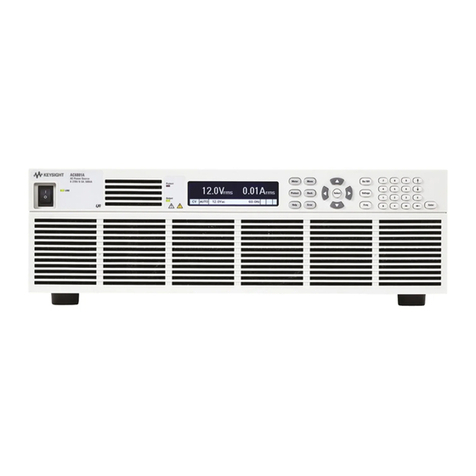
Keysight Technologies
Keysight Technologies AC6800 Series Operating and service guide

PS Audio
PS Audio MultiWave P1200 owner's manual
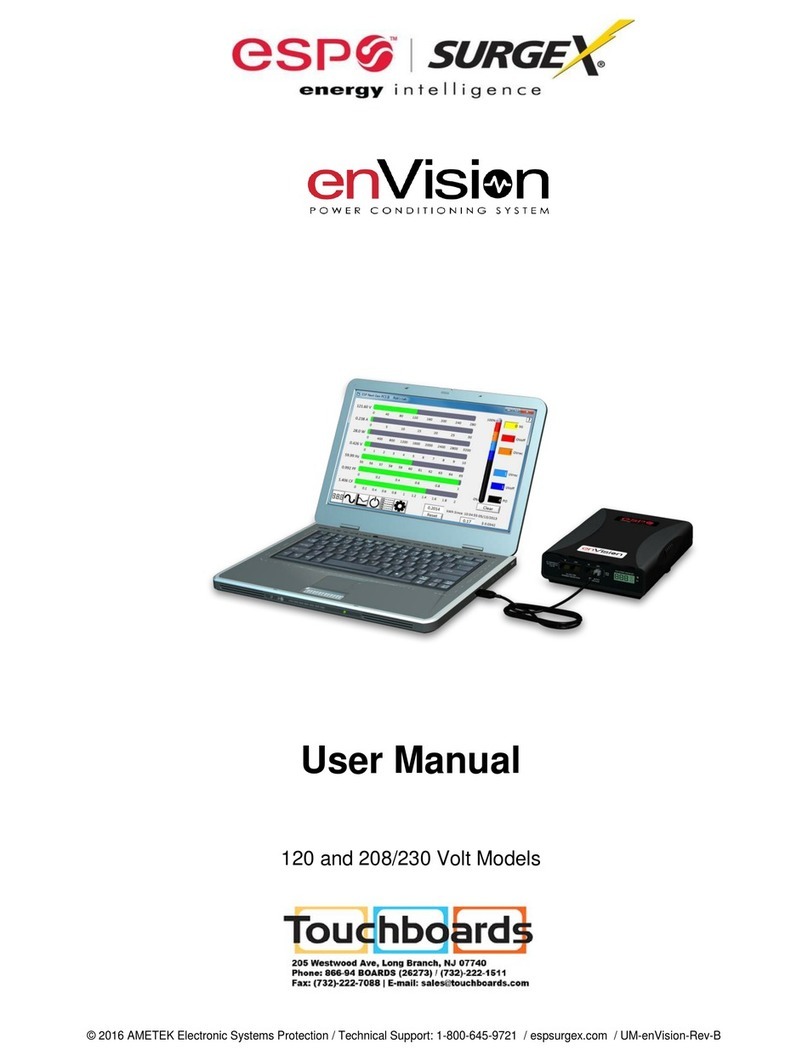
ESP
ESP EnVision EV-12016 BR user manual

Furman
Furman P-1800 AR Prestige Serie owner's manual

AudioQuest
AudioQuest Niagara 7000 quick start guide
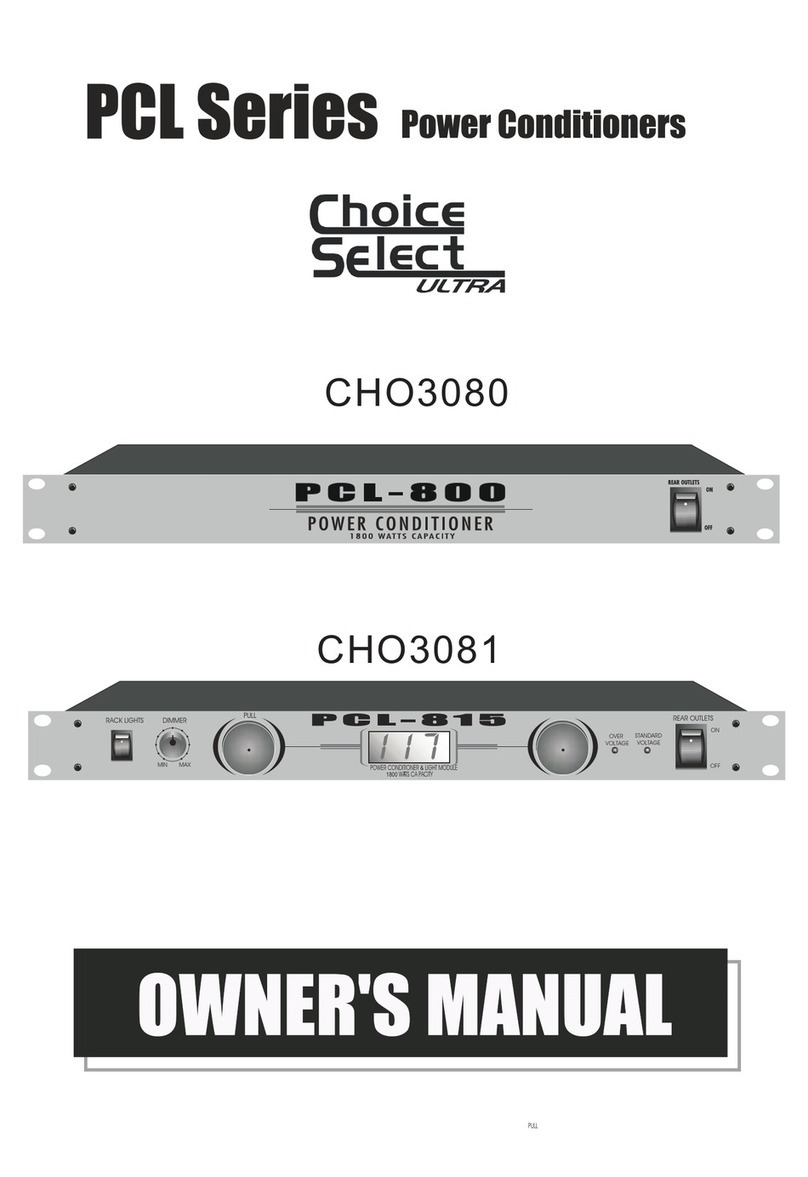
Nady Systems
Nady Systems PCL-800 owner's manual
